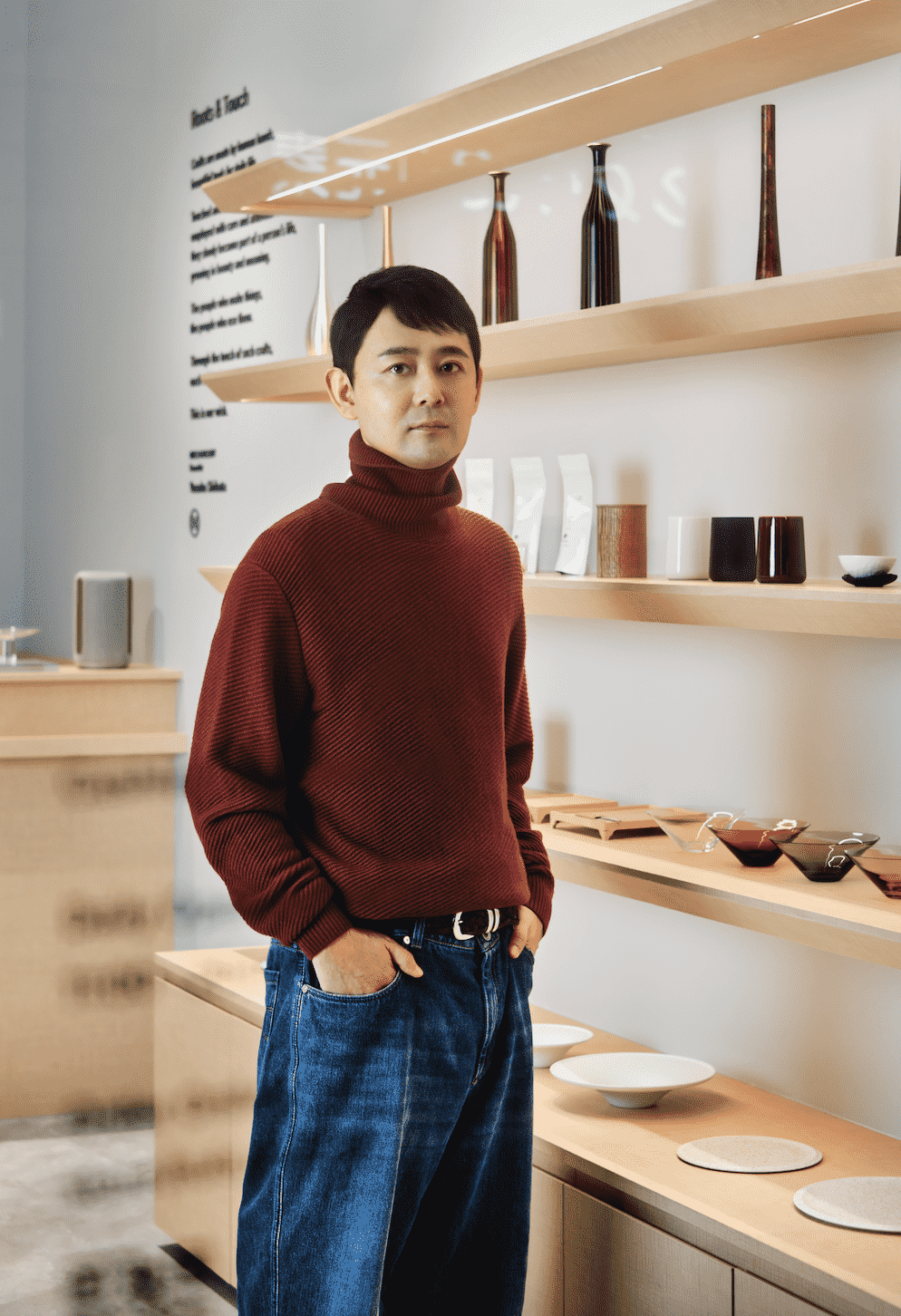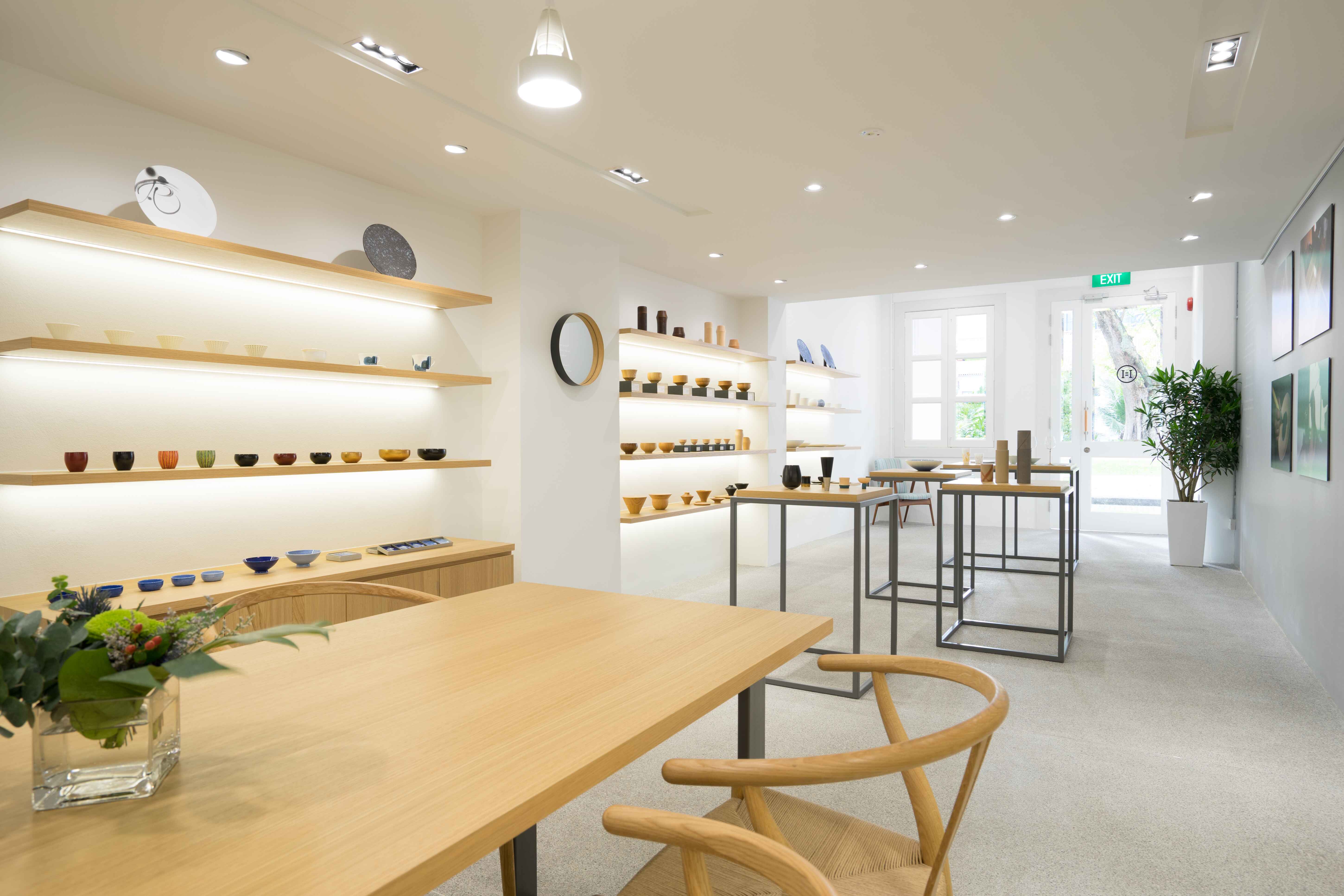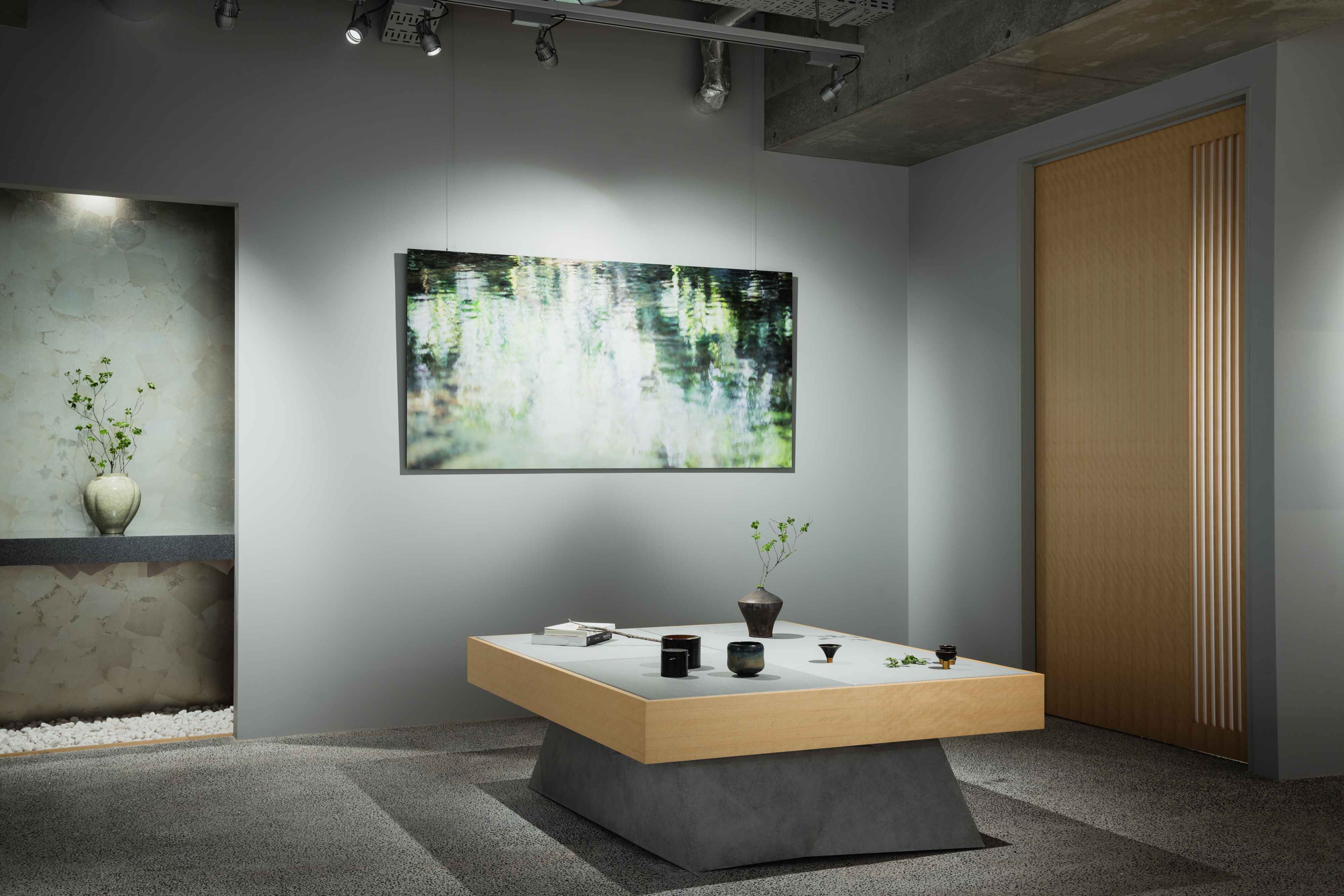At the top of Duxton Hill in Singapore, the genteel atmosphere of leafy foliage and shady shophouse five-foot-way is a fitting prelude to the quietude and contemplative interior of HULS Gallery. Inside, a series of delicate vessels on pedestals made by Takeyoshi Mitsui draw the eye, with their fluid funnel-like forms and chrysanthemum-coloured tints that catch the soft light from the window. On shelves, sakeware, teaware, and tableware are arranged neatly like artworks, each demanding touch with their fine forms, proportions, and strong tactility.

The amiable and attentive gallery founder Yusuke Shibata greets me warmly and satiates my curiosity with detailed explanations. He points out a round teapot with ink-like splatters made in the traditional Sometsuke-style (white porcelain painted with cobalt pigment called gosu) by Riso Porcelain, a manufacturer from Arita in Saga Prefecture. Also, the smooth clay of a red, flat tea pot conceived by the second-generation makers of ceramic manufacturer Jinshu Touen from the Tokoname Aichi Prefecture brings out the umami flavour of kabuse green tea leaves, while its unusual shape allows spreading out of the fluffy tea leaves.
Shibata’s passion and knowledge of Japanese craft is undeniable. It is thus interesting to find out that his initial ambition was totally unrelated. He wanted to be a musician, even playing in a band and cutting an album in his younger days. This led to his choice of study in graphic design. “I needed to promote my music, so I studied design to learn how to create album covers and posters for my live shows,” he smiles. Craft and music are not that different, he asserts. Both involved the creative process of editing, which Shibata relishes. “I'm not good at sketching, but I like concept making and story telling,” he says.
 Turtleneck sweater and jeans from Brunello Cucinelli
Turtleneck sweater and jeans from Brunello Cucinelli
After several years of working as a web designer, he pivoted to the family business, which makes electrical components for companies, such as Panasonic and Sony. This changed the course of his path. “Before, I stayed mainly in Tokyo. After joining the family business, I went overseas a lot to countries like Indonesia, Singapore, and China. I realized I like finding out about different cultures. I was always going to the museums and galleries to see the local art and culture when I travelled,” he shares. In Singapore, he became aware of the locals’ obsession with all things Japanese, so he started HULS Gallery in 2017 to share more about his country’s culture.
The early days were not that easy. HULS Gallery’s products were more unique and expensive than the other shops selling Japanese crafts in Singapore. For example, some of the matcha bowls fetch a four-digit price. Many are used for tea ceremonies and conceived as art pieces. “You can feel it by holding it and seeing it from every angle, even the bottom. Collectors appreciate it. If we explain properly to customers, most understand. Some buy them as gifts. So gradually, our business expanded,” says Shibata, who runs the gallery alongside the family business.
Regardless of price, Shibata tells his customers that the pieces must be used often. “Most of the products change color or texture over many uses. I want customers to enjoy this change, to realize the difference in each product. I believe Japanese craft has a lot of potential to bring something new to our busy daily lives. I want people to take time to relax with our crafts,” he says. Even one minute of waiting for tea to brew without distractions can be a source of calm, which is why the consummate host can often be found brewing tea for customers with special tea leaves that he imported for customers to buy together with the teaware.
 HULS Gallery at Duxton Hill
HULS Gallery at Duxton Hill
The gallery’s name itself reflects Shibata’s passion for people and conscious living. HULS stands for ‘human life and social life’. It was first used for a web design company he started, but its ethos also grounds they gallery. In a column he writes on the website, he reflects how the social aspects of the business – to revitalise Japanese craft industries, confront climate change through selling products that can last generations, and to embrace uniqueness in this ear of mass production – is one of his agendas. “Japanese crafts reflect the individuality of each region; each one is a unique tool that differs slightly from the other. To be aware of these small differences is to respect the individuality and way of life of the person who lives there,” he writes eloquently in a column of the gallery’s website. This was especially jarring for him coming from the electronics industry, where products are designed in one country and made in another.
Shibata’s dual background in design and business is critical to the business. “Most designers don’t have a special business sense and most businessmen don’t have very creative ideas. But I’m pursuing both,” he states. Hence, he is able to relate easily with the artists and artisans while growing the business strategically. Shibata leads the gallery’s branding with a strong web presence using Instagram and a comprehensive website that promotes the products in interesting ways, such as collaborations with Japanese chefs to share recipes of dishes that are displayed on the gallery’s tableware. Shibata also started an online magazine, Kogei Standard, with a comprehensive inventory of the crafts, manufacturers, and artisans.
 HULS Gallery Tokyo
HULS Gallery Tokyo
In 2019, HULS Gallery started displaying its products at Takashimaya, which helps draw customers to the shop. A gallery was also opened in Tokyo that year, in anticipation of the 2020 Tokyo Olympics. While Covid-19 put a dampener on the latter’s initial ambitions, it proved instrumental for growing the business. The English-speaking Tokyo staff can channel queries of the Singapore staff to the artists and artisans, as well as ship goods directly from Japan to countries like America and Europe. “Most overseas galleries and stores selling Japanese crafts don't have staff in Japan so their purchasing is limited. And some of the artists and artisans are very popular in Japan, but don't know how to expand their business overseas. The staff in Tokyo can help by communicating closely with all parties,” says Shibata.
During the pandemic, business flourished as Singaporeans, starved of travel to Japan, turned to HULS Gallery for their Japanese crafts fix. The fine dining market’s boom during this time was also advantageous, as Japanese restaurants like Sushi Kimura and Michelin-starred Terra Tokyo Italian sought customization services at HULS Gallery. Chefs became friends, who introduced Shibata to chefs of fine dining establishments from other parts of the world. “I feel this has a lot of potential. Most of the Japanese tableware wholesalers don't target the fine dining market because quantities are too small. But for our craftsmen, quantities of 10 to 20 are perfect. The chefs also appreciate the value of the pricy tableware,” says Shibata.
This is the direction HULS Gallery is going in the future, as well as to take the business international. In Singapore, a second gallery at Millenia Walk opened this year while an online shop was started in Hong Kong. But through the gallery’s growth, Shibata’s original ambitions remain steadfast. “Of course, we want to sell Japanese crafts, but at the same time, we want to introduce Japanese aesthetics and the Japanese sense of nature through natural materials of stoneware, ceramics, etc. This is our mission.”








 Turtleneck sweater and jeans from Brunello Cucinelli
Turtleneck sweater and jeans from Brunello Cucinelli
 HULS Gallery at Duxton Hill
HULS Gallery at Duxton Hill
 HULS Gallery Tokyo
HULS Gallery Tokyo




 Back
Back
